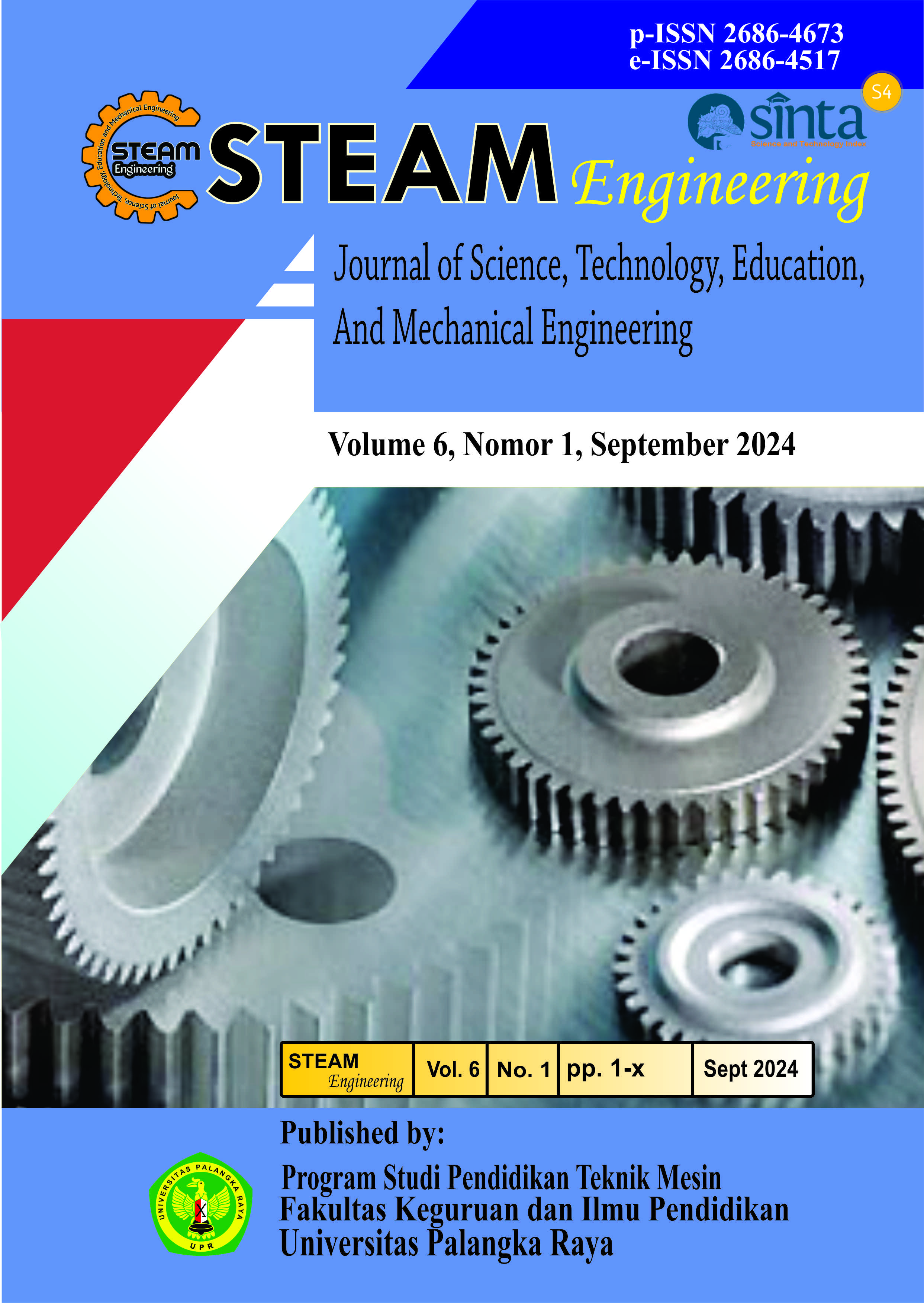TINJAUAN LITERATUR: PENINGKATAN KETAHANAN API DAN SIFAT MEKANIK PADA KOMPOSIT POLIMER DENGAN PENAMBAHAN BAHAN LIMBAH GEOPOLIMER
DOI:
https://doi.org/10.37304/jptm.v6i1.13368Keywords:
Composite, Geopolymer, Polymer, Fire ResistanceAbstract
Composite polymers are now under development and are widely used in automobile manufacturing for interior panels, door panels, and bodywork. The research and development of polymer composites for the automobile manufacturing must have resilient fire resistance requirements. Currently, polymer composites with fire resistance capabilities have been developed with geopolymer materials, which offer benefits and produce excellent performance. Geopolymers are inorganic polymers that contain aluminosilicates, silica oxides, and alumina oxides. They have thermally resistant mechanical characteristics. Geopolymer materials are commonly derived from waste materials, including those utilized as additions to polymer composite materials, specifically coal fly ash and clay-based waste. The purpose of this literature is to discuss the path and progress of waste-based polymer reinforced composite technology for fire resistance. The methodology employed in this study takes a conceptual approach to articles on the influence of adding different types of geopolymer materials on the fire resistance properties of natural fiber reinforced composites. According to the findings, articles involving the inclusion of geopolymer materials tend to lower resistance to tensile and flexural stresses, whilst the addition of this geopolymer material reduces fire resistant qualities.
Downloads
References
Annual Book of ASTM Standars. (2003). Standard Test Method for Rate of Burning and / or Extent and Time of Burning of Plastics in a Horizontal Position.
Cahyono, E. A., Sutomo, & Aris Hartono. (2019). Literatur Review ; Panduan Penulisan dan Penyusunan. Jurnal Keperawatan, 12(2).
Diana, L., Safitra, A. G., & Ariansyah, M. N. (2020). Analisis Kekuatan Tarik pada Material Komposit dengan Serat Penguat Polimer. Jurnal Engine: Energi, Manufaktur, Dan Material, 4(2), 59–67.
Diharjo, K, Prasetya, Y., Masykuri, M., & Suharty, N. S. (2020). Fly ash / ripoxy composite : Inflammability on horizontal and surface burning Fly Ash / Ripoxy. In 1st International Seminar on Advances in Metallurgy and Materials (i-SENAMM 2019) (Vol. 030009).
Diharjo, Kuncoro, Afandi, R., Purwanto, A., Suharty, N. S., & Jihad, B. H. (2013). Adhesive Nanosilica / Aluminium Powder - Epoxy for Joint Application on Composite Car Body of Electrical Vehicle, 13–17.
Diharjo, Kuncoro, & Firdaus, F. (2007). Fire Resistance of Fly Ash - Polyester. Jurnal Teknik Gelagar, 18(February), 86–94.
Diharjo, Kuncoro, Jamasri, & Firdaus, F. (2007). Effect of Particulate Size of Fly Ash and Fly-Ash Weight Fraction To Flexural Properties of Fly Ash –Polyester Composite. In International Conference On Chemical Sciences (ICCS-2007) (pp. 24–26).
Halauddin. (2017). Pengaruh Penambahan Sekam Padi dan Polimer Emulsi Polyvinyl Acecate Co Acrylicpada Tanah Lempung Dengan Objek Pengujian Kekuatan Batu Bata Menggunakan Metode UniaxiaL. Jurnal Inersia, 9(1), 39–46.
Harjani, C., Noviandri, P., Kristen, U., & Wacana, D. (2019). Desain partisi penyerap noise berbahan komposit kain perca. Lintas Ruang, (August). https://doi.org/10.24821/lintas.v7i1.3064
Kuncoro Diharjo, Suharty, N., Nusantar, A., & Afandi, R. (2015). The Effect of Sokka Clay on the Tensile and Burning Properties of rPP / Clay Composite. Advanced Materials Research, 1123, 338–342. https://doi.org/10.4028/www.scientific.net/AMR.1123.338
Nurdin, A., Hastuti, S., D, H. P., & Rino, H. (2019). Pengaruh Alkali dan Fraksi Volume terhadap Sifat Mekanik Komposit Serat Akar Wangi – Epoxy. ROTASI, 21(1), 30–35.
Nurdin, A., & Himawanto, D. A. (2019). Studi numerik kekuatan material transmisi roda gigi pico hydro. JTMI, 14(1), 24–29.
Paunda, F., Imad, K., Muhyi, A., Sumardi, O., & Rojikin, S. (2022). Pengaruh Variasi Fraksi Volume Serat Tandan Kosong Kelapa Sawit dan Serat Ampas Tebu Terhadap Kekuatan Tarik Komposit Hybrid Bermatrik Polyester. Jurnal Foundry, 5(1), 12–18.
Prasetyo, B. D., Diharjo, K., Ariawan, D., Suharty, N. S., & Masykuri, M. (2020). Flexural and inflammability properties of FA / CF / Phenolic hybrid composite Flexural and Inflammability Properties of FA / CF / Phenolic Hybrid Composite. In 1st International Seminar on Advances in Metallurgy and Materials (i-SENAMM 2019) (Vol. 030006). AIP Publishing. https://doi.org/https://doi.org/10.1063/5.0021602
Priyanto, K. (2015). Kekuatan Bending dan Ketahanan Bakar Komposit Hybrid Serat Gelas, Serat Karbon, dan Serbuk Genteng Sokka Dengan Matriks Bisphenol-A. Universitas Sebelas Maret.
Putra, F. U., Paundra, F., Muhyi, A., Hakim, F., Triawan, L., & Aziz, A. (2023). Pengaruh Variasi Tekanan dan Fraksi Volume Pada Hybrid Composite Serat Sabut Kelapa dan Serat Bambu Bermatriks Resin Polyester Terhadap. Jurnal Foundry, 6(1), 8–15.
Siswanto, & Diharjo, K. (2011). Pengaruh Fraksi Volume dan Ukuran Partikel Komposit Polyester Resin Berpenguat Partikel Genting Terhadap Kekuatan Tarik dan Kekuatan Bending. Politeknosains Vol., X(2), 91–99.
Sutrisno, Hari, S. Y., & Mustafa. (2016). Pengaruh Serbuk Geomaterial pda Komposit. In Seminar Nasional Sains dan Teknologi Terapan IV 2016 (pp. 117–122).
Tarigan, R. A. P. (2013). Pengaruh Fraksi Berat Dan Ukuran Serbuk Genteng Sokka Terhadap Ketahanan Bakar Komposit Geopolimer. Universitas Sebelas Maret.
Zhou, J., Yao, Z., Chen, Y., Wei, D., & Wu, Y. (2013). Thermomechanical analyses of phenolic foam reinforced with glass fiber mat. Materials and Design, 51, 131–135. https://doi.org/10.1016/j.matdes.2013.04.030












